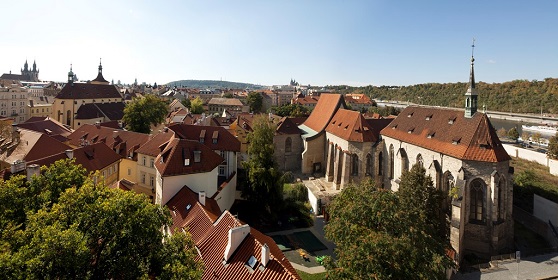
The National Gallery will present the restored Anežský Monastery
 |
| photo: NG in Prague |
Prague - The previously closed gardens of the Prague Convent of St. Agnes, a significant Gothic building in the Old Town, will open to the public. The National Gallery (NG) in Prague has completed nearly two years of restoration of the oldest building in its care, which holds a long-term exhibition of medieval art. The garden has been closed since the floods in 2002. It now features new entrances from the riverbank, new furniture, and is adorned with two dozen sculptures by contemporary authors, the NG announced in a press release.
The convent will open to the public in its new form on Tuesday as part of a program called "Anežka Nově!" starting at 5:00 PM. The restoration of the convent and gardens cost 37 million crowns, of which 30 million were grants from Norwegian funds, and the project was supported by a grant from Iceland, Liechtenstein, and Norway.
Few passersby are aware that behind the walls of the dual convent of both male and female orders, near which a controversial building nicknamed "marshmallow" is set to rise, lies an oasis in the form of gardens. Although the convent was abolished in 1782, its Gothic architecture has been preserved to an unprecedented extent, said Štěpánka Chlumská, curator of the NG's Collection of Old Art. The gallery acquired the property in 1963 and opened the garden at the northern gate in the 1980s, but it has not been reopened since the flood in 2002.
The gardens will now be accessible seasonally and free of charge; in summer, people will be able to stay there even after the exhibition closes. In the summer, it will also be possible to enter the convent of the Poor Clares and the Order of Friars Minor through the freely accessible gardens, allowing access to the entrances of the Salvator Sanctuary and the presbytery of St. Francis Church. The remains of the Friars Minor convent have been restored thanks to a grant. From October 26, a new guided tour will be available in the area. In addition to the commented route through the historical architecture of the convent of the Poor Clares and the Friars Minor, the exhibition will include a lapidarium with archaeological findings from the site, collected over nearly three quarters of a century of explorations. The NG has more than 800 of these artifacts, with nearly sixty items in the exhibition mapping primarily the period of the convent's construction during its peak flourishing in the time of Agnes of Přemysl.
A separate route is also prepared for child visitors. The gardens, for which František Skála created new structures, could delight children as well. One called "Přístěnek" is aimed at the youngest, while the "Sluneční vozík" operates with unexpected experiences of perceiving colors and shapes through the material of the sculptural object. The sculpture park will feature works by Aleš Veselý, Jaroslav Róna, Stanislav Kolíbal, and Karel Malich. The concept is complemented by one of the first sculptures by František Bílek, the monumental sculpture "Golgotha" (1892).
The long-term exhibition located in the upper floor of the convent complex presents Gothic art from the Central European area. Among the top exhibits and treasures of national cultural heritage are works from the period of the Luxembourgs - the Master of the Vyšší Brod Altarpiece, Master Theodorik, Master of the Třeboň Altarpiece, and works associated with the renewed prosperity of the Czech lands during the rule of the Jagiellonians.
The English translation is powered by AI tool. Switch to Czech to view the original text source.
0 comments
add comment











